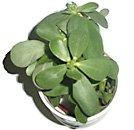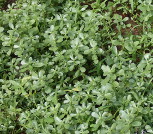
Purslane nutrition facts
Soft, succulent purslane leaves have more omega-3 fatty acids than in some of the fish oils. If you are a vegetarian and pledge to avoid all forms of animal products, then here is the answer! Go for this healthy dark-green leafy vegetable and soon you will forget fish!
Botanically, this herbaceous leafy vegetable belongs to the family of Portulacaceae and scientifically known as Portulaca oleracea.
Other common names in place for this green leafy are pursley, pigweed, or verdolaga.
 |  |
| Purslane (Portulaca oleracea). | Purslane herb. |
Purslane is native to Indian sub-continent and now distributed widely across the continents but actually as a wild weed. There exist varieties of pusley with variation in leaf size, thickness, and leaf arrangement and pigment distribution. This hardy herb plant requires relatively less water and soil nutrients and grows well sunny climates. The plant grows up to 12-15 cm in height as a low-lying spread.
Purslane is widely grown in many Asian and European regions as a staple leafy vegetable. Its leaves appear thick, mucilaginous and have a slightly sour and salty (piquant) taste. Leaves and tender stems are edible. In addition to succulent stems and leaves, its yellow flower buds are also favoured, especially in salads.
Purslane seeds, appear like black tea powder granules, are often used to make some herbal drinks.
Health Benefits of Purslane
- This wonderful green leafy vegetable is very low in calories (just 16 kcal/100g) and fats; nonetheless, it is rich in dietary fibre, vitamins, and minerals.
- Fresh leaves contain surprisingly more omega-3 fatty acids (α-linolenic acid) than any other leafy vegetable plant. 100 grams of fresh purslane leaves provide about 350 mg of α-linolenic acid.
- Research studies show that consumption of foods rich in omega-3 fatty acids may reduce the risk of coronary heart disease, stroke, and help prevent the development of ADHD, autism, and other developmental differences in children.
- It is an excellent source of Vitamin-A, (1320 IU/100 g, provides 44% of RDA) one of the highest among green leafy vegetables. Vitamin-A is a known powerful natural antioxidant and an essential vitamin for vision. It is also required to maintain healthy mucosa and skin.
- Consumption of natural vegetables and fruits rich in vitamin-A is known to help to protect from lung and oral cavity cancers.
- Purslane is also a rich source of vitamin-C, and some B-complex vitamins like riboflavin, niacin, pyridoxine and carotenoids, as well as dietary minerals, such as iron, magnesium, calcium, potassium, and manganese.
- Furthermore, present in purslane are two types of betalain alkaloid pigments, the reddish β -cyanins, and the yellow β -xanthins. Both pigment types are potent antioxidants and have been found to have antimutagenic properties in laboratory studies. [Proc. West. Pharmacol. Soc. 45: 101-103 (2002)].
Click Here For More Articles
Don't forget to opt-in to Our Healthy Living Society and get 3 free gifts while receiving the latest information on health, well-being and groundbreaking news about natural nutrition.

No comments:
Post a Comment